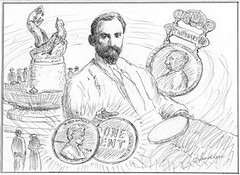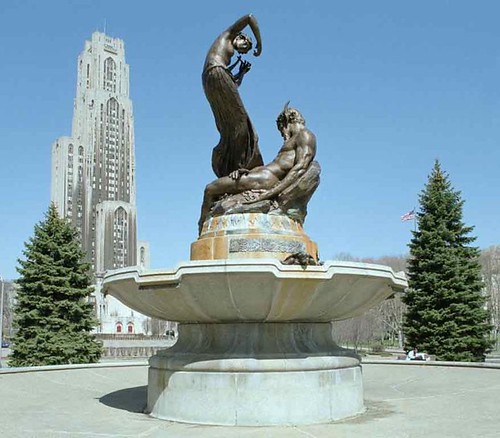
PREV ARTICLE
NEXT ARTICLE
FULL ISSUE
PREV FULL ISSUE
NEWSPAPER PROFILES COIN DESIGNER VICTOR DAVID BRENNER A New England newspaper published an article this week profiling Lincoln Cent designer Victor David Brenner. Brenner once had a studio in Ogunquit, ME. The article mentions Brenner's first sculptural work in the round, the Song to Nature fountain in Pittsburgh. Coincidentally, just before discovering this article I was corresponding with Dick Johnson about Brenner works in Pittsburgh and dug out images for him. Included below is an image of the fountain, a magnificent sculpture. -Editor  The obstacles sculptor and medalist, Victor David Brenner, had to overcome to see his design for the Lincoln penny — finally minted in 1909 — were minor compared to challenges he faced in his native Lithuania before emigrating to America. The obstacles sculptor and medalist, Victor David Brenner, had to overcome to see his design for the Lincoln penny — finally minted in 1909 — were minor compared to challenges he faced in his native Lithuania before emigrating to America.Near the end of his career, Clara Whiteside, wife of well known artist Frank Reed Whiteside, interviewed Victor Brenner at his Ogunquit studio overlooking Perkins Cove. He had been born Viktoras Barnauskas in Shavli, Lithuania, in 1871. At the age of 13 he began an apprenticeship in his father's metal shop and quickly displayed a precocious gift for engraving. At the tender age of 16 he went into business for himself. Victor arrived in New York in 1890 with no knowledge of the English language, but his superior engraving skills quickly earned him a comfortable living. After eight years, he felt creatively unsatisfied by the work. "I gave in to the discontent that was troubling me — threw up my work and sailed for Paris," he told Clara. There he studied with accomplished medalist, Louis Oscar Roty, and entered Academie Julian. Upon his return to New York, his artistic talents were recognized by well-placed numismatists who encouraged his concentration on commemorative medals. Brenner's proposed design for the Panama Canal service medal was selected by President Theodore Roosevelt, whose flattering likeness was to be depicted thereon. While the President posed for the artist, the two men developed a comfortable rapport, so much so that Victor felt within the bounds of propriety to suggest that the Indian head on the United States penny be replaced by his sculpture of President Abraham Lincoln. Roosevelt was persuaded, much to the chagrin of the Chief Engraver at the U.S. Mint, Charles E. Barber, who tried every unctuous trick in the book to discredit Brenner and the quality of his work. Nonetheless, a Victor David Brenner design for the new coin was finally approved by the President and the Secretary of the Treasury. Victor David Brenner's initials were re-introduced on the front of the Lincoln penny in 1918 just after Charles E. Barber retired from the U.S. Mint.  During the same year what could arguably be described as Brenner's masterwork — the Mary Schenley Memorial Fountain, also known as A Song to Nature — was unveiled at the entrance to Schenley Park in Pittsburgh, Pa. The magnificent 30-foot public sculpture in bronze and granite portrays a reclining Pan being serenaded by a graceful female companion. Carla Whiteside's enlightening article was widely published in 1920, but it did not reveal the circumstances that led to Brenner's departure from the motherland. Numismatic expert, David W. Lange, uncovered the particulars in his 2005 book, "The Complete Guide to Lincoln Cents." Victoras Barnauskas' work so exceeded that of his rival engravers in Lithuania that they resented the number of commissions the teenager took from them. He was accused of counterfeiting. The police, frustrated in trying to obtain evidence of the crime that had never occurred, came into his shop and asked him to duplicate an official seal. Unaware that it was illegal to do so, young Viktor made a perfect copy and was thrown into jail. With the help of some friends he managed to escape and fled to the United States. To read the complete article, see: The Lincoln penny designed by Ogunquit artist (www.seacoastonline.com/articles/20090625-LIFE-906250372) Wayne Homren, Editor The Numismatic Bibliomania Society is a non-profit organization promoting numismatic literature. See our web site at coinbooks.org. To submit items for publication in The E-Sylum, write to the Editor at this address: whomren@gmail.com To subscribe go to: https://my.binhost.com/lists/listinfo/esylum All Rights Reserved. NBS Home Page Contact the NBS webmaster 
|